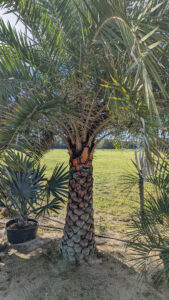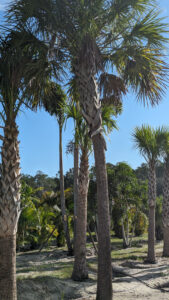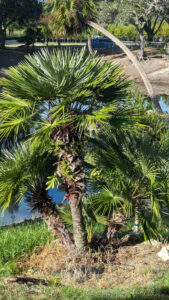
Sylvester Palm (Phoenix sylvestris) Photo by: Anna Stubbendick, Canterbury Farms
The fall equinox is upon us, and you know what that means – cooler weather is (hopefully) just around the corner. As we bid farewell to the sweltering summer heat, it’s the perfect time to shift our focus to some fabulous, cold-hardy palm varieties that thrive right here in Central Florida climate. Whether you’re a seasoned green thumb or just dipping your toes into gardening, we’ve got the scoop on the palms that’ll add a touch of tropical flair to your landscape, even when temperatures dip.
Sylvester Palm (Phoenix sylvestris)
Our first contender is the Sylvester Palm, a robust choice that can handle Central Florida’s occasional chilly nights. These palms are known for their striking silver-blue fronds and can grow up to 40 feet tall. Be sure to plant them in well-draining soil and provide regular watering during dry spells.

Senegal Date Palm (Phoenix reclinata) Photo by: Anna Stubbendick, Canterbury Farms
Senegal Date Palm (Phoenix reclinata)
If you’re searching for a cold-hardy palm that’s also exceptionally drought-tolerant, the Senegal Date Palm might be your answer. These large multi-trunk palms boast graceful arching fronds and adapt well to various soil types. Just remember to trim dead fronds to keep them looking their best.
Pindo Palm (Butia capitata)
Pindo Palms, also known as Jelly Palms, add a touch of elegance to any garden. With their feathery fronds and vibrant orange fruit, they’re as attractive as they are hardy. Plant them in full sun and provide occasional fertilization for optimal growth.
Queen Palm (Syagrus romanzoffiana)
Queen Palms are a classic choice for Central Florida landscapes, known for their tall stature and feathery fronds. These palms thrive in well-draining soil and require regular pruning to remove dead leaves and promote healthy growth.
Mule Palm (Butiagrus x nabonnandii)
Looking for a unique twist on the classic palm? The Mule Palm is a hybrid between the Pindo Palm and the Queen Palm, offering the hardiness of both parents. These palms can handle chilly nights like a champ and are a fascinating addition to your garden.

Sabal Palm (Sabal palmetto) Photo by: Anna Stubbendick, Canterbury Farms
Sabal/Cabbage Palm (Sabal palmetto)
The State tree of Florida, the Sabal Palm is an iconic choice for local landscapes. They’re incredibly cold-hard palms and can withstand temperatures well below freezing. Give them plenty of space to grow and watch them thrive.
Chinese Fan Palm (Livistona chinensis)
For those who appreciate a touch of the exotic, the Chinese Fan Palm is a splendid choice. These slow-growing palms feature fan-shaped fronds and adapt well to Central Florida’s climate. Plant them in a sunny spot with well-draining soil.
European Fan Palm (Chamaerops humilis)
European Fan Palms bring a Mediterranean charm to your garden. Their fan-shaped leaves can withstand colder temperatures, and they’re surprisingly low-maintenance. Just be sure to provide adequate drainage to avoid waterlogged roots.

European Fan Palm (Chamaerops humilis) Photo by: Anna Stubbendick, Canterbury Farms
Windmill Palm (Trachycarpus fortunei)
A personal favorite for Central Florida gardens, the Windmill Palm can endure frost and even snow, making it a top choice for colder winters. They’re relatively slow-growing and require well-draining soil to flourish.
Bismarck Palm (Bismarckia nobilis)
With their striking silver-blue fronds and towering presence, Bismarck Palms are a showstopper in any landscape. They can handle cooler temperatures but thrive in full sun and well-draining soil.
Saw Palmetto (Serenoa repens)
For a native touch, consider planting Saw Palmettos. These tough, low-growing palms are excellent for natural landscaping and require minimal care once established.

Sago Palm (Cycas revoluta) Photo by: Anna Stubbendick, Canterbury Farms
Cycad Varieties (Sagos, Coonties, Cardboard Palms)
Don’t forget about cycads! Sagos, Coonties, and Cardboard Palms are not true palms but share a similar appearance. These ancient beauties are incredibly cold-hardy palms and add a prehistoric charm to your garden.
Planting and Care Tips:
- Planting: When planting any of these palms, ensure the hole is twice as wide, but only just as deep as the root ball. Make sure the root ball is set just at or slightly above the finish grade. Water thoroughly after planting and mulch to retain moisture.
- Pruning: Regularly remove dead fronds to encourage healthy growth and prevent disease. Always trim fronds from the bottom of the head of the palm, and never trim from the center or the “heart” or you’ll risk permanent damage or even death of the palm.
- Watering: Most cold-hardy palms prefer well-draining soil. Water deeply but infrequently, allowing the soil to dry out slightly between waterings.
- Fertilization: Feed your palms with a balanced palm fertilizer in the spring and early summer for lush growth.
So, as we usher in the fall equinox this weekend, let’s embrace the prospect of cooler weather and celebrate the versatility of these cold-hardy palms that thrive in Central Florida. Whether you want to create a lush tropical paradise or add a touch of elegance to your garden, these palms have got you covered. Swing by Canterbury Farms Nursery & Garden Center to explore our wide selection and embark on your journey to a greener, more vibrant landscape. Happy gardening! 🌴🌿🌞
By: Anna Stubbendick, FCHP
For more information, check out these additional links:
Palms for Central Florida – UF/IFAS
Palms for North Florida – UF/IFAS
Cold Damage on Palms – UF/IFAS
Summer is the Perfect Time to Plant Palms – Canterbury Farms

